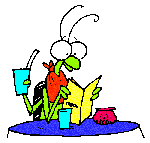
University of Kentucky Department of Entomology







What is it about North American culture that keeps us from using one of our most abundant and readily available food sources, insects? We could learn a lot from our international neighbors. Many cultures around the globe have evolved to use insects in their diets. There was probably some trial and error involved because not all insects are edible. In fact, some insects are poisonous. But there are lots of insects that are safely eaten by people around the world. Eating Insects in the Past...Algeria - The natives of Algeria would collect large numbers of desert locusts to use as food. They were a valuable resource for the poor population. The locusts were cooked in salt water and dried in the sun. Not only were they collected for personal use, but the locusts were traded in the markets as well. Australia - Australian natives, known as Aborigines, have eaten many different insects throughout history. Hundreds of Aborigines would come together at the Bogong mountains to feast on Bogong moths. These moths would gather in large numbers on the cave floors and in rock crevices. They were harvested, cooked in sand and stirred in hot ashes. This would burn off the wings and legs. The moths were then sifted through a net to remove their heads before they were eaten by the Aborigines. Some of the moths were ground into paste and made into cakes. Another important insect in the Aboriginal diet was the witchety grub. This was a moth larva that lived in the roots of the acacia bush, also known as the witchety bush. The grubs were eaten raw or cooked in ashes. Cooked grubs supposedly taste like almonds. The grubs were a valued food source in the Australian desert, especially to women and children. Some of the insects eaten by the Aborigines were very sweet. The natives would dig into the ground looking for the nests of honeypot ants. The workers of these ants collect honeydew from scales and psyllids and feed it to other worker ants, which would become storage containers for the sweet liquid. The "storage" workers could be found in the nests. The "honeybag" bee, a stingless native bee, also provided sweet treats for the Aborigines. The "honeybag" was actually the bees' hive. In order to find the "honeybag," the Aborigines would catch a bee that was feeding on nectar, use sticky plant juice to stick a leaf or flower petal to it, and set it loose. The bee would fly straight home. The attached leaf or petal would slow down the bee and make it easier to see and follow. ... and Present! Japan - The Japanese have used insects as human food since ancient times. The practice probably started in the Japanese Alps, where many aquatic insects are captured and eaten. Thousands of years ago, this region had a large human population but a shortage of animal protein. Since the area had an abundance of aquatic insects, this food source became very important for human survival. The Japanese still use insects in many recipes. If you were to go to a restaurant in Tokyo, you might have the opportunity to sample some of these insect-based dishes
Most of these insects are caught wild except for silk moth pupae. They are by-products of the silk industry. Silk moths are raised in mass for their ability to produce silk. The larvae, the young silk moths, produce the silk. Once they pupate, they can no longer produce silk and are then used as food. Kwara State, Nigeria, West Africa - People from this area have been known to feast on termites, crickets, grasshoppers, caterpillars, palm weevil larvae, and compost beetle larvae. Termites are collected by placing a bowl of water under a light source. The termites are attracted to the light and will then fall into the water. If large numbers of termites are gathered, they are sold at local markets. People of all ages eat the winged reproductive termites, but the queen termites are considered a delicacy and are only eaten by adults. The termites are roasted over a fire or hot coals or fried in a pot. After cooking, the wings are removed and salt is added to taste. Crickets are collected from soil tunnels which they build. The crickets are roasted over a fire or hot coals. The guts are removed before eating. Several taboos surround eating crickets. Members of the Yoruba tribes do not generally eat crickets. Many worship Ogun, the iron god, and he forbids animals that have no blood. Others believe that eating crickets is childish. Grasshoppers are prepared and eaten in a manner similar to that for crickets, but there are more grasshoppers than crickets. They are eaten by people of all ages and there are no taboos associated with them. Some farmers will eat uncooked grasshoppers after they remove the grasshoppers' guts. In some parts of Nigeria, the Cirina forda Westwood larva is reported to be the most important and widely eaten insect. This insect, often called Kanni, is a caterpillar that is collected from the sheabutter tree. It is boiled and dried in the sun before it is eaten. Kanni is widely used as an ingredient in vegetable soup in this region. A very large edible insect is the palm weevil larva. It can be four inches long and more than two inches wide. The mature larvae are fleshy and grublike with a high fat content. These insects are collected from the trunks of palm trees. They are fried in a pot or frying pan. They are reported to be very delicious. The compost beetle larvae are even larger than the palm weevil larvae. They live in garbage or manure piles or swampy areas. The end of the abdomen, which contains the guts, is removed before the larvae are washed and fried. Some people refuse to eat this insect because it is found in such "dirty" places. Bali - Dragonfly and damselfly adults are hunted in Bali. Dragonflies are extremely difficult to catch but several interesting techniques have been used successfully. Latex, sticky plant juice, from the jackfruit tree is applied to the end of a slender stick. This stick is tied to a longer, sturdier stick. The stick is lower to a resting dragonfly and with a quick tap, the dragonfly is stuck to the plant juice. Dragonflies are also captured by hand, but one must be very quiet and quick. If latex is used to catch the insects, it is removed with cooking oil before the dragonflies are cooked. Sometimes the dragonflies are placed directly on the grate of a charcoal grilled for cooking. Another method involves boiling them with ginger, garlic, shallots, chili pepper and coconut milk. The wings are removed before cooking unless they are charcoal roasted. References Cherry, R. H. 1991. Use of insects by Australian Aborigines. American Entomologist 37: 9-13. Fasoranti, J. O., and D. O. Ajiboye. 1993. Some edible insects of Kwara State, Nigeria. American Entomologist 39: 113-116. Pemberton, R. W. 1995. Catching and eating dragonflies in Bali and elsewhere in Asia. American Entomologist 41: 97-102. Pemberton, R. W., and T Yamasaki. 1995. Insects: Old food in new Japan. American Entomologist 41: 227-229. Note: If you are having a hard time locating these references, try your local college or university's entomology department. American Entomologist is a journal that is published by the Entomology Society of America and many entomologists are members of this society. | ||||
Bug food and mantid cartoons courtesy of C. Ware, copyright 1997
Last updated: 20 January 1999

 Return to UK Department of Entomology Katerpillars page
Return to UK Department of Entomology Katerpillars page Return to UK Department of Entomology homepage
Return to UK Department of Entomology homepage Return to University of Kentucky homepage
Return to University of Kentucky homepage